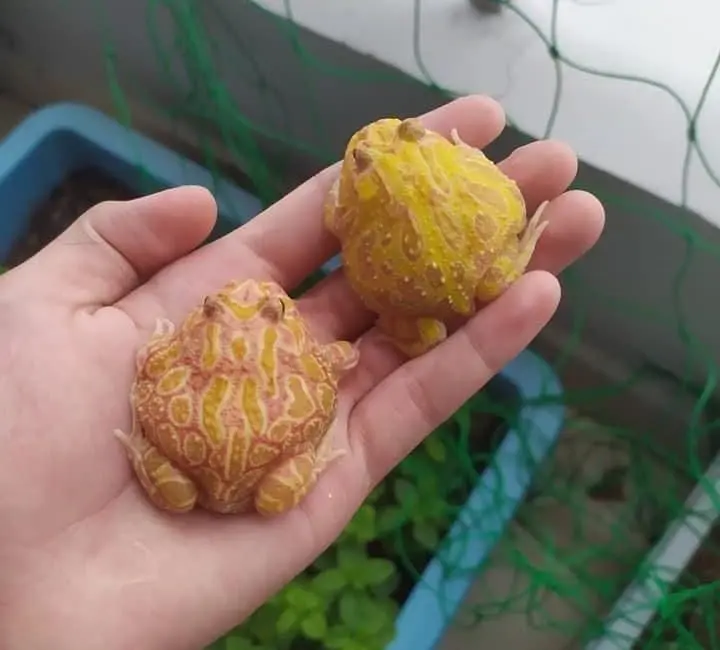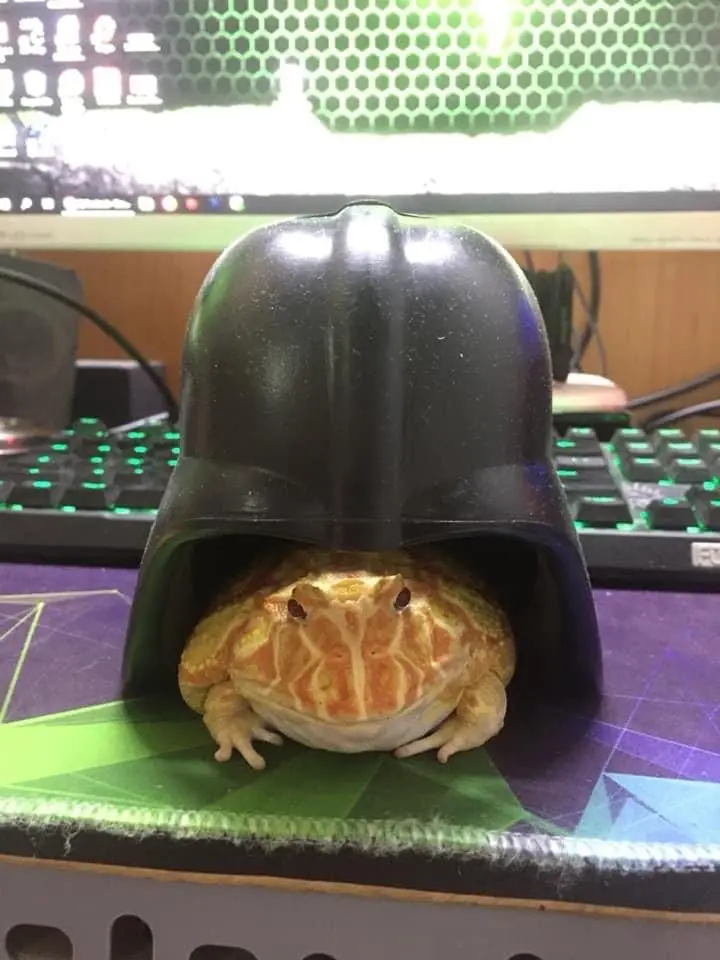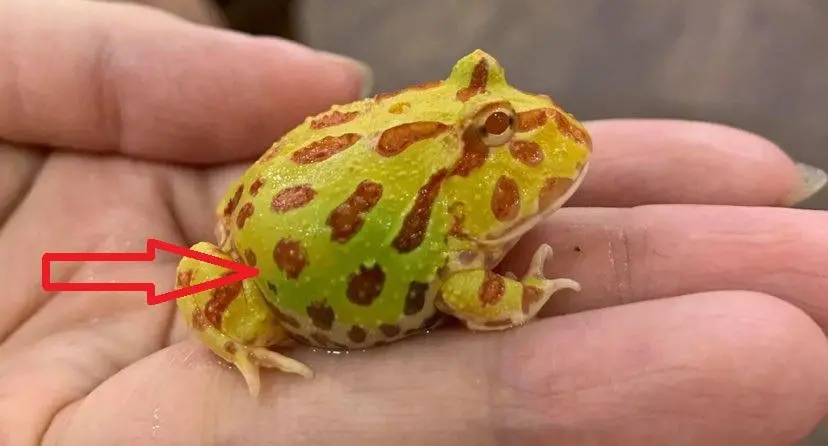Albino Pacman frogs are popular amphibian pets. You may be wondering whether to buy a regular or albino Pacman frog. Maybe you’re ready to bring your new baby albino home and want to know any special care your new pet may require.
Continue reading for useful care and advice on caring for these amazing amphibians.
Note that this care sheet is not just for regular albino Pacman frogs but also for strawberry, sunburst, apricot Pacman frogs as they are different types of Albinos.
Table of Contents
What is an Albino Pacman Frog?
Albino Pacman frogs have a lack of pigmentation. Therefore, they tend to have a yellow and orange skin tone, which sets them apart from the regular Pacman frog we all know, which is green with brown.
The albino has red eyes, which immediately sets it apart from other Pacman frogs.
You can buy a host of albino Pacman morphs.
Bellows are different types of Albinos that you can easily find on the market.

Different types of albino Pacman frogs
Regular Albino Pacman Frog
This albino Pacman frog morph is plain yellow without any other coloration. It is a very popular choice with Pacman frog owners.
Strawberry Pacman Frog
The strawberry morph is named after the colors of the fruit it resembles. It has red and orange color on the back with a creamy white belly and orange to red spots.
Strawberry Pineapple Pacman Frog
The strawberry pineapple albino Pacman looks similar to the standard strawberry morph, except it has more pink tones that are dull due to the lack of pigmentation.
This morph also has red eyes, which is due to the lack of pigmentation, therefore the blood vessels in the eyes are visible, making the eye appear red in color.
Sunburst Pacman Frog
The sunburst albino Pacman is the yellow color of the albino with strawberry coloration. The colors are still lighter than standard morphs, but still a beautiful choice when selecting an albino Pacman frog.
Apricot Pacman Frog
Similar to the sunburst albino, the apricot albino is the albino yellow coloration with bursts of apricot, making it a unique and sought after Pacman morph.
4 Spot Patternless Albino Pacman Frog
This albino morph is one of the most uncommon you will find. It has a light yellow and pink color with reduced patterns, but it has four spots on its back.
Why Do Albino Pacman Frogs Need Special Care?
Albinos are found in humans, animals, reptiles, and amphibians around the world. It is the lack of melanin, or pigmentation in the skin, which results in a number of health problems for the pet.
Eyes
Albino Pacman frogs may suffer with eye developmental problems, this is due to melanin being responsible for eye part development, including eye muscles, retina, and optic nerve.
The lack of melanin could result in eye developmental issues, which can cause problems such as depth perception and focus.
Sunlight
Sunlight can be very dangerous for albino Pacman frogs, as they have no protection against the ultraviolet rays of the sun. While uncommon, some animals have died from UV radiation because they didn’t have the protection that they need.
This can also increase the chances of your albino Pacman frog getting skin cancer if exposed to sunlight for extended periods.
Hearing Problems
It’s not uncommon for albino animals to have a hearing impairment, which means your frog may not be able to hear a noise.
Are Albino Pacman Frogs Good Pets?

Albino Pacman frogs are great pets
The Pacman frog is a favored amphibian pet for beginners. It is hardy, large in size, and doesn’t need a huge enclosure.
The albino Pacman frog is a great pet and it offers variety with the host of morphs. The albino will require some careful consideration when setting up their enclosure, such as lighting which will be discussed further in this care sheet.
Overall, they are easy to care for pets for first time amphibian owners and seasoned Pacman frog owners.
Albino Pacman Frog Care Sheet
Availability
The albino Pacman frog can be found through a host of certified breeders. The standard Pacman is easier to find, but you shouldn’t have to search too far to find an albino.
Size
When you first bring your albino Pacman frog home it may only be a few weeks old, but don’t be fooled, these frogs can grow to adult size within a year. Females can grow up to 5 to 7 inches in length, while the male tends to be slightly smaller.
Lifespan
These frogs are known to live ten to 15 years in captivity, in the safety of their enclosure. When choosing an albino Pacman frog, you are making a long-term commitment to its care and well-being.
Sexing
You will only be able to tell if your albino Pacman frog is male or female when it’s an adult.
The male frog will croak, while females may scream from time to time. If your frog croaks when the dog barks, when the doorbell chimes, or when you put on the vacuum cleaner, then chances are your frog is male.
A male Pacman will also have a dark bump on his hands.
More details on how to identify the gender of a Pacman frog.
Housing
Pacman frogs are big and lazy frogs that spend their time burrowed in their substrate with just their eyes sticking out as they wait for prey to make its way past them, so they can catch and feed. Therefore, these frogs don’t need a large enclosure to move around in.
Once adult size these frogs can be kept in a 10 to 20 gallon enclosure, while babies can be kept in small plastic enclosures.
Related –Best Pacman frog terrariums.
Lighting
The albino Pacman frogs’ eyes are sensitive to light due to the lack of melanin. Therefore, you don’t need to provide light in their enclosure. The light in the room is more than enough.
If you have created a bioactive enclosure for your albino Pacman frog and have live plants which need light for thriving, then you will want to use LED light which will not cause any damage to your frog, as the pale skin cannot handle the harsh UV rays from sunlight bulbs offered in reptile stores.
Temperature
Pacman frogs spend most of their time burrowed in the ground, staying cool in the damp substrate.
In captivity, the layer of substrate isn’t enough to provide the protection it provides in the wild, which is why room temperature is recommended, which should be between 75ºF and 85ºF .
Related – Learn ways maintain ideal temperature in a Pacman frog enclosure.
Humidity
These frogs enjoy high humidity levels of between 60% and 80%. You will need to provide ventilation.
These frogs are prone to bacterial infections, which can result from humid and stagnant conditions.
Use a digital hygrometer to monitor your humidity levels and ensure you are providing the ultimate conditions for your amphibian pet.
Related – High humidity levels in the tank can grow mold. Learn ways to maintain ideal humidity and prevent mold.
Substrate
Your albino Pacman frog will spend most of the time burrowed in the substrate, so your substrate selection is imperative.
They need a good substrate that allows the frog to dig, so look for coconut fiber reptile substrate, which is excellent at holding humidity.
You place it in the enclosure damp, which also enables your frog to stay cool. Don’t forget to add a water bowl that is shallow enough for your frog to sit in.
Related –Best substrate for Pacman frogs.
Feeding
One of the reasons the Pacman frog is such a top choice with beginner frog owners is that they have a voracious appetite and will eat anything that will fit in their mouth, which is why a diet of crickets and roaches is best suited.
You can feed your albino frog fish, worms, and small mice.
The amount you feed should be based on your albino Pacman frog size and the temperature.
If your frog has cooled down and started drying out for brumation, then they are not going to eat.
If your Pacman frog is getting too round, then maybe you need to cut back on feeding. Remember in the wild your frog would eat everything it can as quickly as possible, as it doesn’t know when its next meal is going to walk past.
Adult frogs should be fed once to twice a week, while juveniles should be fed daily.
Supplements
Calcium with Vitamin D3
Pacman frogs need a supplement of Vitamin D3 and calcium to help grow strong bones and help with egg laying. The best way to provide this supplement to your frog is to cover the crickets in the calcium powder before feeding.
You can do this by adding the crickets to a plastic bag and adding the supplement, give it a good shake before adding the crickets to the enclosure.
Multivitamins
Your albino Pacman frog should be given a multivitamin once a week that has the essential vitamins and minerals your frog needs to remain healthy.
A multivitamin offers a complete balanced mineral and vitamin solution for your frog including Vitamin A, Vitamin K, and more.
Choose a multivitamin in powder form, so you can use it as you do the calcium and Vitamin D3 powder, dusting the crickets before feeding to ensure your amphibian pet gets all the vitamins and minerals it needs.
Related –Pacman frog food chart and feeding scheldule.
Handling
Albino Pacman frogs are not a dog or cat and while they don’t really mind being handled, you shouldn’t handle them unless you don’t have a choice, such as when carrying out enclosure maintenance or transporting your amphibian pet to the vet.
Remember that an adult Pacman has teeth and they can draw blood, so be careful and gentle when handling.
Ensure you have damp hands when handling your frog. Your frog absorbs moisture through its skin and the oils, soaps, and hand lotions on your hand can be absorbed into the frog.
Why is My Albino Pacman Frog Turning Green?

An albino Pacman frog is turning green at the side after eating
You’ve searched at all the shops and with the breeders and eventually found the most beautiful albino Pacman frog and a few weeks later it starts turning green. It’s not uncommon to be worried at this point. The good news is that it is not uncommon.
In fact, many albino Pacman frogs will go green at some point, usually on their sides and on the top their heads. This is often noticed during digestion just after eating.
Once the food is digested, the frog’s color returns to its normal yellow or orange coloration.
Albino Pacman Frog Common Illnesses
Bacterial and Fungal Infections
Pacman frogs can experience a bacterial or fungal infection, which is common in amphibians. You may notice swelling, redness, or pus, which are all signs of infection.
Parasitic Infections
These frogs can also experience parasitic infections at some point in their lives, often resulting in a lack of appetite, even though your enclosure conditions are at optimum.
Only your vet will be able to take a sample to diagnose if parasites could be the cause.
Respiratory Infections
While respiratory infections are not that common in amphibians, Pacman frogs can get a respiratory infection if they don’t have enough humidity in their enclosure.
You may notice your frog is more lazy than normal, its wheezing or drooling.
This could be fatal and immediate veterinary treatment is required.
Skin Cancer
While exceptionally rare in captive albino Pacman frogs, if your frog’s enclosure has a sunlight bulb that gives off UV rays, then your frog can develop skin cancer.
Impaction
Pacman frogs eat anything that walks past them that will fit in their mouth, including other Pacman frogs.
It’s not uncommon when grabbing their food that they take some substrate in at the same time, which can result in impaction, also known as constipation. Small gravel is often passed in feces, but any larger pieces can cause a blockage.
If your Pacman frog is showing no interest in its food, is climbing in its water dish often and straining to poop, then your albino Pacman frog could be impacted.
You can find more information about impaction in Pacman frogs here.